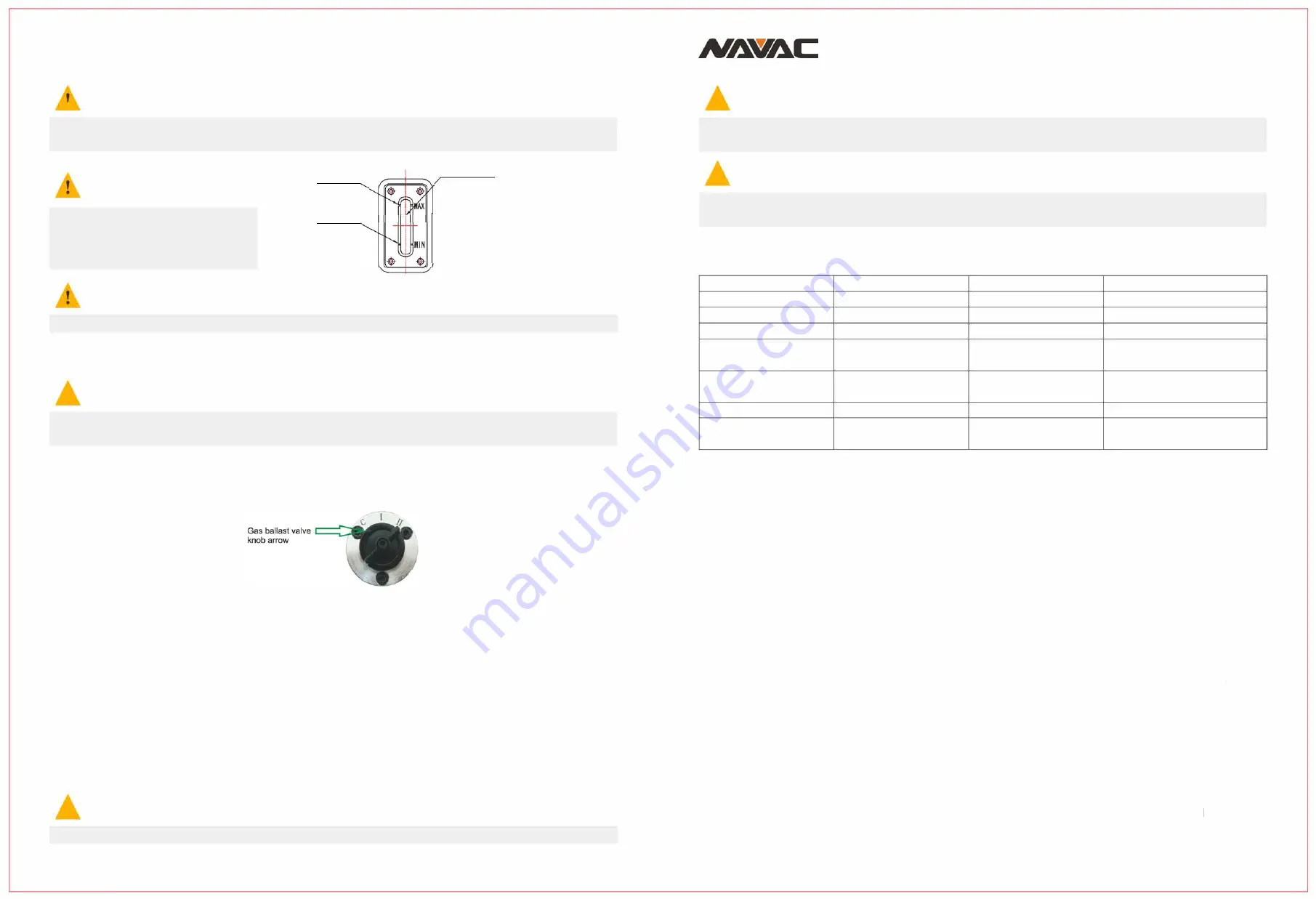
NA
Y
AC
•
Warning
The oil level shall be kept between position MAX and MIN of oil sight glass. Excessive or insufficient oil will decrease the
pump performance or even cause malfunction. The pump must be stopped before adding oil.
Warning
Make sure the gas flow at the exhaust port
is not blocked or restricted in anyway. Do
not start the pump if the exhaust port is
blocked.
Notice
Max oil level
Min oil level
I
Fig. 6
The operating ambient temperature is 10 - 40 C and humidity should be less than 85%.
7 .2 Operation
t
Notice
•
Recommended
oil level
High temperature hazard! Do not touch the surface! The surface of the pump could be very hot during operation and after
shutdown within one hour.
Pumping non-condensable gases
Close the gas ballast to pump non-condensable gases (Set the gas ballast to position C, refer to Fig. 7). The ultimate pressure
will rise (loss of vacuum) with gas ballast opened.
Fig. 7 Gas Ballast Valve
Pumping condensable gases and vapor
If the vacuum system contains a small amount of condensable gas, open the gas ballast valve (Set the gas ballast to position I or
II, refer to Fig. 7) and keep the pump running for at least 30 minutes to pump the condensable gas effectively. Close the gas ballast
valve when the vacuum system pressure is reduced to a certain value. If the pump operates at low temperature, condensable gas
may be dissolved in the pump oil. The oil may be emulsified or deteriorated which will affect the pump performance, even cause
corrosion of the pump body.
The rise of oil level during pump operation is a sign of condensable gas contained in the vacuum system.
Do not switch off the pump immediately when the process is finished. Keep the pump running with gas ballast open and intake port
closed until all gases dissolved in the oil are removed.
8. Inspection and Maintenance
!
Warning
All checks and maintenance must be performed by trained personnel in accordance with local safety rules and regulations.
8
!
Warning
In case of presence of hazardous substances due to oil decomposition or media sucked into the pump, it's necessary to define
the hazard and take all necessary safety precautions.
!
Warning
In the presence of hazardous substances, determine the hazard in the first time and follow all appropriate safety procedures. If
the potential hazard still exists, the pump must be decontaminated before any maintenance.
8.1 Routine inspection
Content
Operation
Interval
Remarks
Oil level
Visual inspection
Every three days
8.2.1
Oil color
Visual inspection
Every three days
8.2.1
Pump noise
Acoustic inspection
Every three days
8.2.2
Pump vibration
Visual inspection
Every three days
Check the pump feet or feet bolts
in case of abnormal vibration.
Pump temperature
Temperature meter
Every one week
Check and clean fan of the pump
and motor for deposits.
Seal & O-ring
Visual inspection
Every one month
Replace it if necessary
Dirt trap
Visual inspection
Every one month
Check and clean the foreign matter.
Dry it by compressed air.
Table3
8.2 Maintenance
8.2.1 Checking oil level
1) The oil level shall be always kept between position MAX and
MIN
of oil sight glass during operation (refer to Fig. 6). Add oil
when the oil level is lower than position
MIN
and discharge oil by removing the oil drain plug (refer to Fig. 1) when the oil level
is above position MAX.
2) Check the oil color. Replace the oil if the color is other than clear and transparent.
8.2.2 Checking pump's noise
The pump noise shall be continuous and stable during operation. If any abnormal noise is found, refer to Table 4 Troubleshooting.
8.2.3 Changing oil
1) Change the oil when the pump is switched off and cooled down.
2) Remove the oil drain plug (Fig. 1) and drain the used oil into a suitable receptacle. When the flow of oil stops, screw on the
oil drain plug and start the pump shortly (10 seconds). Switch off the pump, remove the plug again and drain the residual oil.
Screw on the oil drain plug (Check O-ring, replace it if necessary). Remove the oil fill plug (Fig. 1) and fill in fresh pump oil
which is specified or provided by the manufacturer.
3) After oil changing, handle the used oil stored in an assigned container according to local relevant environmental laws and regulations.
8.2.4 Regularly checking intake filter and anti-suckback valve
Regularly take down the intake port and clean the filter by compressed air. Check the seal position of anti-suckback valve for
cleanness, damage, hardening and height.
8.2.5 Regularly checking fan cover and motor fan
Regularly remove the clean the fan cover and motor fan. Clean them by compressed air and reinstall them properly before pump
operation.
9


























